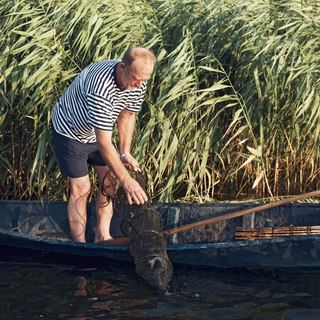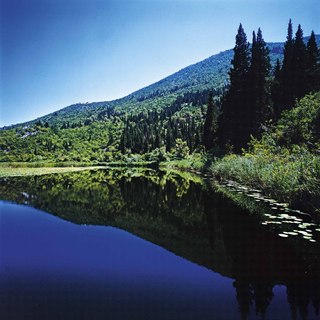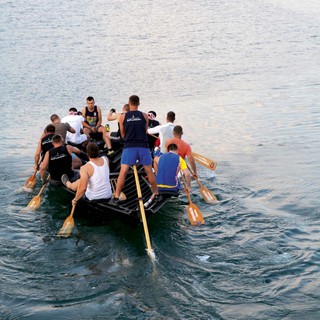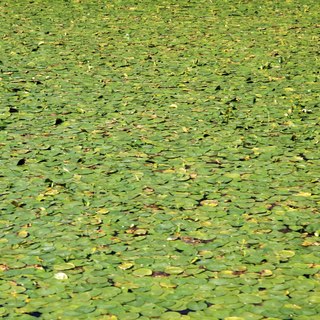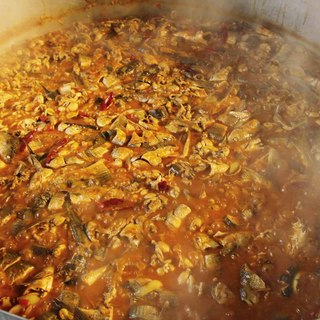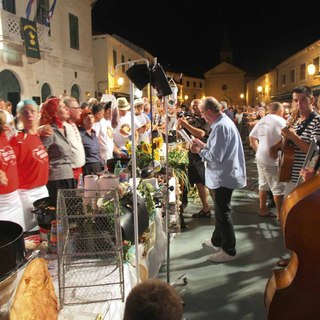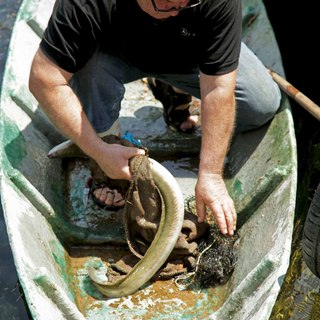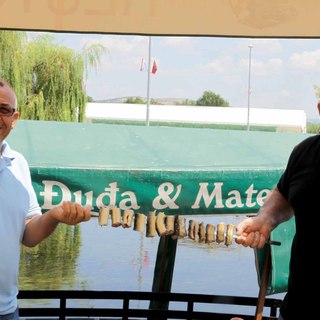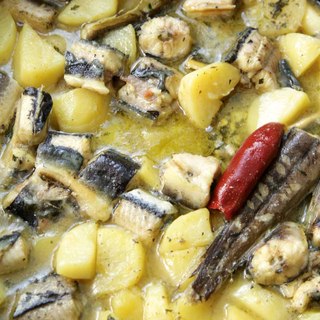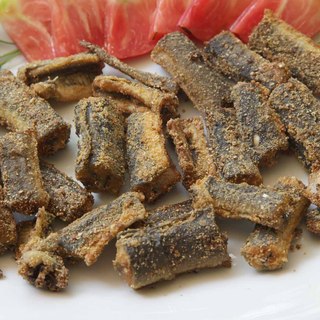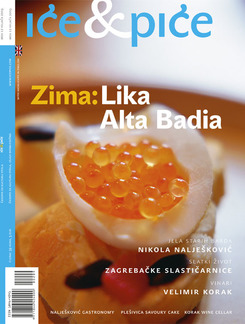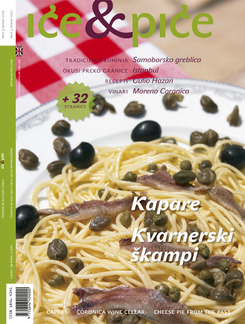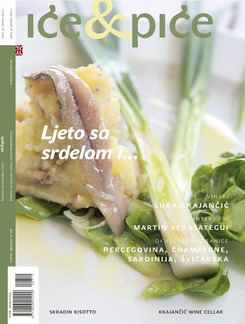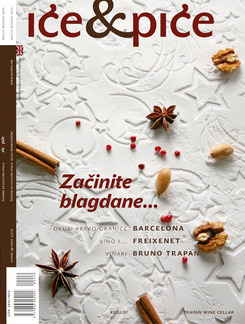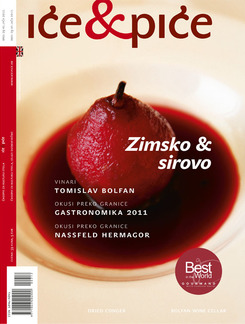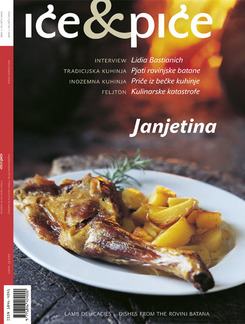We are at the very estuary of the Neretva, which flows like molten silver to the sea, as if it were itself some vast eel, that uncommon and perhaps most puzzling of all fish. Its Croatian name, jegulja, has clear roots in the ancient languages, for the Roman cooks and naturalists called it anguilla, and the whole family of herpetifom fish is named after the eel, anguilliformes. Its life, birth and death are wrapped in mystery, yet when the eel reaches its greatest weight and size, before the adults head off for that last time to the Sargasso Sea, they are sometimes called in Croatian bačina. This is from bak, a big bull, from which Bačinska jezera (lakes) at the very mouth of the Neretva in turn took their name. And from the smallest specimens of eel to the great bulls, through the centuries in the valley of the Neretva a unique set of recipes has been written out and cooked from, surviving as a treasured reliquary of gastronomy to this very day. In parallel, techniques have evolved for catching the timid queen of the whole area of the Neretva, around Vid, Metković, Opuzen, Rogotin and the actual outlet into the sea.
And of course, there would be neither eel nor dishes of eels were it not for the Neretva River and its great delta, its indigenous boats, famed vessels the appearance of which has changed but little since the Neolithic and Antiquity, very similar to the more northerly and better known liburnia, and the ships that are identical in terms of naval architecture with which the Duchy of the Neretva and the early Croatian kingdom controlled shipping and kept its own sea – via piracy. These mighty archaic ships, in whose honour each August a thrilling and exhausting Neretva Marathon is organised, go along with the smaller hulls from which nets and lobster pots are hauled and which still slip among the channels of the fertile Neretva fields from which come vegetables, olives and grapes, without which it is impossible to imagine the Neretvan eel cookbook, have become the trademark of the Neretva area. Since these ancient times, with just such vessels but also from the river banks, eels have been hunted and inveigled in ways just like those of today. The Neretva fishermen have caught them in pots, with nets, dragnets, drag lines, and bunches of branches in which the eels wriggle their serpentine bodies and get caught in the twigs. Along with these bunches, the oldest manner for catching eels in this country, whatever of their various names are used, is with a pole onto the end of which the fishermen tie worms, sometimes chicken guts, and as the eel won’t let go of its prey once it has fastened on it, the fishermen make us of its obstinate greed and pull out the catch.
In line with all these ancient catching techniques, the recipes for cooking the eel are both ancient and well at one with the overall Mediterranean tradition. We can mention the Iberian caldeirade, the Basque pots, the French matelots, the bronze cauldrons of the Italian capitons, bačina as we call it, in the various sauces and compare them with our brujet/brodet of which today we distinguish those of the Neretva from those of Prokljan or Skradin eels that in the stony bottom of the Prokljan Lake are so cleansed of ooze that they poach them, famed with Venetian gourmets as Bisati lesati di Scardona or those that are grilled or fried from the Neretva and the mouth of the Cetina.
And so the cookery book for the preparation of eels, particularly that from the Neretva, is weighty. And yet this serpentine fish is vanishing from our markets, fishmongers and even our tales, and so the recipes are falling slowly but ineluctably into oblivion. Still, there is no old Dalmatian book of recipes, from Dika Marjanović Radica to Ghioa Calus, and particularly no Neretva book, like the excellent Echo of the Neretva by Ms Emerika Bijač, that does not contain a least a few recipes with the attribution of narentin a la Neretva. But one has to say that all these ancient regular Neretva ways of preparing the eel are conditional upon and determined by the growth of this strange fish. The biggest and the fattest, silver and dark green to yellow specimens, are first of all scorched on griddles or skewers, and then salted and dried for winter when they are prepared according to a recipe like that for stockfish, white, with potato, or fresh, in original Neretva pots with chard and borecole. The smaller ones are the base for the famed Neretva brujet, which in this one-of-a-kind river valley has several versions, as well as other Croatian fish casseroles of eel, of which the Skradin stew and eel with peas are select dishes from the menu of these great travellers. The big ones in the Neretva are caught in the autumn, when they muster in the delta and set about preparing for their amazing final adventure. The medium sized, called bizots from the Venetian bisato, are terrific on the grill and fried, are particularly suitable for stews in the Neretva and are caught all year round, since they spend their adult life in the mainstream courses. At the end, there are the smallest, yellow and see-through, little eels, once a special treat, carefully cleaned of mucus, only fried, and if a bit bigger, baked, boiled, and dried, previously pressed and salted in the sun. They have just arrived from their home town, the seabed of the distant Caribbean, led by senses and urges known only to them. For several long and dangerous months they make the long trip from the Sargasso to Europe, to the great rivers of Portugal and the Pays Basque, in which they are mercilessly hunted down, via southern France, Italy, the Po delta, to our own and Greek river basins, from the Bojana and the Mirna, the Zrmanja, Krka and Cetina, and of course, the great Neretva.
This great trek of the eel was equally exciting to ancient and to medieval gastronomists and naturalists, who cite a mass of uncommon events related to the adventures of this snake-like fish, which is repeated each year. And yet, above all else, they laud the uniquely unctuous taste of the eel from the colony of Narona and the River Naron, as this great Roman city by what is today Vid was called, and the River Norin and Neretva. In fact, this recognisable smell and taste, assured that in the rich cookery book of eel dishes, this slimy, squirmy fish remained mentioned as curious, even repugnant, but above all a fish of outstanding quality, which since ancient times the old masters recommended to the emperors, three of whom (Carus, Carinus and Numerian) were by origin from the colony of Narona, later writers to their crowned noble dukes, kings, princes rulers and gluttonous Holy Fathers, equally bewildered and uninitiated into the long journey from life to death, death to life of the always secret eel for which for a thousand years the Neretva has been home, and the old and famed Neretva recipes are a mirror of their outstanding taste and smell.

